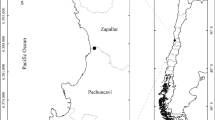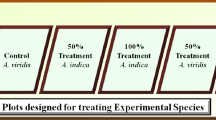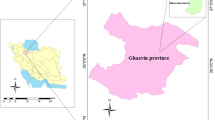Abstract
Purpose
This study was designed to evaluate the possible effects of some chelating agents on phytoremediation efficiency and plant growth parameters of Amaranthus caudatus L. and Tagetes patula L. in soils contaminated with lead.
Method
The plant species were grown in pots and treated with lead nitrate and in combination with 2.5, 2.0 and 2.5 mmol/kg of EDTA, SA and CA, respectively.
Results
The results showed that the highest accumulations of Pb (mg/kg) with 0.74 and 0.13 were found in the roots and stems of A. caudatus exposed to 400 mg/kg Pb containing EDTA and SA, respectively. Moreover, the highest accumulation of Pb in the roots and stems of T. patula with 0.87 and 1.5 mg/kg were observed in 400 mg/kg Pb- contaminated soil containing SA.
Conclusions
Although the results obtained showed that T. patula would have a better phytoextraction potential than A. caudatus, it should be noted that due to the Pb behavior in the soil and/or leaching of Pb from the soil columns during the irrigation period the low amounts of Pb absorption by the root and aerial parts of the plants compared to the added doses of Pb(NO3)2 solution to the soil samples, imply the studied plants haven’t the adequate potential for phytoextraction of Pb from contaminated soils.






Similar content being viewed by others
References
Alaboudi KA, Ahmed B, Brodie G. Phytoremediation of Pb and cd contaminated soils by using sunflower (Helianthus annuus) plant. Ann Agr Sci. 2018;63(1):123–7.
Alkorta I, Hernández-Allica J, Becerril JM, Amezaga I, Albizu I, Onaindia M, et al. Chelate-enhanced phytoremediation of soils polluted with heavy metals. Rev Environ Sci Biotechnol. 2004;3:55–70.
Al-Masri MS, Al-Akel B, Nashawani A, Amin Y, Khalifa KH, Al-Ain F. Transfer of 40K, 238U, 210Pb, and 210Po from soil to plant in various locations in south of Syria. J Environ Radioactiv. 2008;99:322–31.
Baghaie AH, Aghilizefreei A. Effects of salicylic acid, humic acid, and EDTA chelate on the increasing Pb concentration in the barley inoculated with PGPR. J Adv Environ Health Res. 2020;8(1):10–8.
Bai J, Xiao R, Gong A, Gao H, Huang L. Assessment of heavy metal contamination of surface soils from typical paddy terrace wetlands on the Yunnan plateau of China. Physic Chem Earth. 2011;36:447–50.
Bardiya-Bhurat K, Sharma S, Mishra Y, Patankar C. Tagetes erecta (marigold), a phytoremediant for Niand Pb-contaminated area: a hydroponic analysis and factors involved. Rendiconti Lincei. 2017;28(4):673–8.
Barona A, Aranguiz I, Elias A. Metal associations in soils before and after EDTA extractive decontamination: implications for the effectiveness of further clean-up procedures. Environ Pollut. 2001;113:79–85.
Carter MR, Gregorich EG. Soil Sampling and Methods of Analysis. 2nd ed. Boca Raton: CRC Press, Taylor and Francic Group; 2007. 33487–2742, p. 1262
Cay S, Uyanik A, Soner Engin M, Kutbay HG. Effect of EDTA and tannic acid on the removal of cd, Ni, Pb and cu from artificially contaminated soil by Cavan. Int J Phytoremediat. 2015;17(1–6):568–74.
Chen H, Cutright T. EDTA and HEDTA effects on cd, Cr, and Ni uptake by Helianthus annuus. Chemosphere. 2001;45:21–8.
Chen YX, Lin Q, Luo YM, He YF, Zhen SJ, Yu YL, et al. The role of citric acid on the phytoremediation of heavy metal contaminated soil. Chemosphere. 2003;50:807–11.
Chen YH, Li XD, Shen ZG. Leaching and uptake of heavy metals by ten different species of plants during an EDTA-assisted phytoextraction process. Chemosphere. 2004;57:187–96.
Dahiya S, Karpe R, Hegde AG, Sharma RM. Lead, cadmium and nickel in chocolate and candies from suburban areas of Mumbai, India. J Food Compos Anal. 2005;18:517–22.
Davodpour R, Sobhanardakani S, Cheraghi M, Abdi N, Lorestani B. Honeybees (Apis mellifera L.) as a potential bioindicator for detection of toxic and essential elements in the environment (case study: Markazi Province, Iran). Arch Environ Contam Toxicol. 2019;77(3):344–58.
Drzewiecka K, Mleczek M. Salicylic acid accumulation as a result of cu, Zn, cd and Pb interactions in common reed (Phragmites australis) growing in natural ecosystems. Acta Physiol Plant. 2017;39:182.
Ebrahimi M. Effect of EDTA treatment method on leaching of Pb and Cr by Phragmites australis (Cav.) Trin. Ex Steudel (common reed). Caspian J Environ Sci. 2015;13(2):153–66.
Evangelou MWH, Ebel M, Schaeffer A. Evaluation of the effect of small organic acids on phytoextraction of cu and Pb from soil with tobacco (Nicotiana tabacum). Chemosphere. 2006;63:996–1004.
Garbisu C, Alkorta I. Phytoextraction: a cost-effective plant-based technology for the removal of metals from the environment. Bioresour Technol. 2001;77(3):229–36.
Gardea-Torresdey J, Peralta-Videa J, Montes M, De La Rosa G, Corral-Diaz B. Bioaccumulation of cadmium, chromium and copper by Convolvulus arvensis L.: impact on plant growth and uptake of nutritional elements. Bioresour Technol. 2004;92:229–35.
Ghosh A, Manchanda N. Phytoremediation of heavy metals from water of Yamuna River by Tagetes patula, Bassica scoparia, Portulaca grandiflora. Asian Plant Res J. 2019;2(2):1–14.
Giordani C, Cecchi S, Zanchi C. Phytoremediation of soil polluted by nicked using agricultural crops. Environ Manag. 2005;36(5):675–81.
Godwin PM, Pan Y, Xiao H, MT Afzal MT. Progress in preparation and application of modified biochar for improving heavy metal ion removal from wastewater. J Biores Bioprod. 2019;4:31–42.
Gupta DK, Srivastava A, Singh VP. EDTA enhances lead uptake and facilitates phytoremediation by vetiver grass. J Environ Biol. 2008;26:903–6.
Kayser A, Wenger K, Keller A, Attinger W, Felix HR, Gupta SK, et al. Enhancement of phytoextraction of Zn, cd, and cu from calcareous soil: the use of NTA and sulfur amendments. Environ Sci Technol. 2000;34:1778–83.
Khosropour E, Attarod P, Shirvany A, Grant Pypker T, Bayramzadeh V, Hakimi L, et al. Response of Platanus orientalis leaves to urban pollution by heavy metals. J For Res. 2019;30:1437–45.
Kovács V, Gondor OK, Szalai G, Darkó É, Majláth I, Janda T, et al. Synthesis and role of salicylic acid in wheat varieties with different levels of cadmium tolerance. J Hazard Mater. 2014;280:12–9.
Lai H-Y, Chen Z-S. Effects of EDTA on solubility of cadmium, zinc, and lead and their uptake by rainbow pink and vetiver grass. Chemosphere. 2004;55:421–30.
Liphadzi MS, Kirkaham MB, Mankin KR, Paulsen GM. EDTA-assisted heavy-metal uptake by poplar and sunflower grown at a long-term sewage-sludge farm. Plant Soil. 2003;257:171–82.
Lombi E, Zhao FJ, Dunham SJ, McGrath SP. Phytoremediation of heavy metal contaminatedsoils: natural hyperaccumulation versus chemically enhanced phytoextraction. J Environ Qual. 2001;30:1919–26.
Luo C, Shen Z, Li X. Enhanced phytoextraction of cu, Pb, Zn and cd with EDTA and EDDS. Chemosphere. 2005;59:1–11.
Luo C-L, Shen Z-G, Baker AJM, Li X-D. A novel strategy using biodegradable EDDS for the chemically enhanced phytoextraction of soils contaminated with heavy metals. Plant Soil. 2006;285:67–80.
Luo J, Qi S, Gu XWS, Wang J, Xie X. An evaluation of EDTA additions for improving the phytoremediation efficiency of different plants under various cultivation systems. Ecotoxicology. 2016;25:646–54.
Makino T, Kamiya T, Takano H, Itou T, Sekiya N, Sasaki K, et al. Remediation of cadmium-contaminated paddy soils by washing with calcium chloride: verification of on-site washing. Environ Pollut. 2007;147(1):112–9.
Mani D, Kumar C, Patel NK, Sivakumar D. Enhanced clean-up of lead-contaminated alluvial soil through Chrysanthemum indicum L. Int J Environ Sci Technol. 2015;12:1211–22.
Martínez-Villegas N, Flores-Vélez LM, Domínguez O. Sorption of lead in soil as a function of pH: a study case in México. Chemosphere. 2004;57:1537–42.
Meers E, Hopgood M, Lesage E, Vervaeke P, Tack FMG, Verloo M. Enhanced phytoextraction : in search for EDTA alternatives. Int J Phytoremediat. 2004;6(2):95–109.
Pandey S, Gupta K, Mukherjee AK. Impact of cadmium and lead on Catharanthus roses - a phytoremediation study. J Environ Biol. 2007;28:655–62.
Pavlović M, Rakić T, Pavlović D, Kostić O, Jarić S, Mataruga Z, et al. Seasonal variations of trace element contents in leaves and bark of horse chestnut (Aesculus hippocastanum L.) in urban and industrial regions in Serbia. Arch Biol Sci. 2017;69(2):201–14.
Pereira BFF, de Abreu CA, Herpin U, de Abreu MF, Berton RS. Phytoremediation of lead by jack beans on a Rhodic hapludox amended with EDTA. Sci Agric. 2010;67(3):308–18.
Purakayastha TJ, Viswanath T, Bhadraray S, Chhonkar PK, Adhikari PP, Suribabu K. Phytoextraction of zinc, copper, nickel and lead from a contaminated soil by different species of Brassica. Int J Phytoremediat. 2008;10(1):61–72.
Qu J, Cq L, Yuan X, Xh W, Cong Q, Wang L. The effect of sodium hydrogen phosphate/citric acid mixtures on phytoremediation by alfalfa & metals availability in soil. J Soil Sci Plant Nutr. 2011;11(2):85–95.
Ramana S, Biswas AK, Singh AB, Ajay Ahirwar NK, Subba RA. Tolerance of ornamental succulent plant crown of thorns (Euphorbia milli) to chromium and its remediation. Int J Phytoremediat. 2015;17(1–6):363–8.
Romeh AA, Khamis MA, Metwally SM. Potential of Plantago major L for phytoremediation of lead-contaminated soil and water. Water Air Soil Pollut. 2016;227:9.
Sabzevari E, Sobhanardakani S. Analysis of selected heavy metals in indoor dust collected from city of Khorramabad, Iran: a case study. Jundishapur J Health Sci. 2018;10(3):e67382.
Saminathan SKM, Sarkar D, Andra SS, Datta R. Lead fractionation and bioaccessibility in contaminated soils with variable chemical properties. Chem Spec Bioavailab. 2010;22(4):215–25.
Sinhal VK, Srivastava A, Singh VP. EDTA and citric acid mediated phytoextraction of Zn, cu, Pb and cd through marigold (Tagetes erecta). J Environ Biol. 2010;31:255–9.
Sipos P, Németh T, Mohai I, Dódony I. Effect of soil composition on adsorption of lead as reflected by a study on a natural forest soil profile. Geoderma. 2005;124:363–74.
Shao Z, Lu W, Naser J, Zhang J, Yan L. Growth responses and accumulation characteristics of three ornamentals under copper and lead contamination in a hydroponic-culture experiment. Bull Environ Contam Toxicol. 2019;103:854–9.
Sobhanardakani S, Heydari A, Khorasani NA, Arjmandi R. Development of new bioformulations of Pseudomonas fluorescens and evaluation of these products against damping-off of cotton seedlings. J Plant Pathol. 2010;92(1):83–8.
Sobhanardakani S, Tayebi L, Farmany A. Toxic metal (Pb, hg and as) contamination of muscle, gill and liver tissues of Otolithes rubber, Pampus argenteus, Parastromateus niger, Scomberomorus commerson and Onchorynchus mykiss. World App Sci J. 2011;14(10):1453–6.
Sun Y-b, Zhou Q-x, Diao C. Effects of cadmium and arsenic on growth and metal accumulation of cd-hyperaccumulator Solanum nigrum L. Bioresour Technol. 2008;99:1103–10.
Sun Y-b, Zhou Q-x, An J, Liu Y-t, Liu L. Chelator-enhanced phytoextraction of heavy metals from contaminated soil irrigated by industrial wastewater with the hyperaccumulator plant (Sedum alfredii Hance). Geoderma. 2009;150(1–2):106–12.
Sun Y, Zhou Q, Xu Y, Wang L, Liang X. Phytoremediation for co-contaminated soils of benzo[a]pyrene (B[a]P) and heavy metals using ornamental plant Tagetes patula. J Hazard Mater. 2011;186:2075–82.
Tariq SR, Ashraf A. Comparative evaluation of phytoremediation of metal contaminated soil of firing range by four different plant species. Arab J Chem. 2016;9:806–14.
Turgut C, Pepe MK, Cutright TJ. The effect of EDTA and citric acid on phytoremediation of cd, Cr and Ni from soil using Helianthus annuus. Environ Pollut. 2004;131:147–54.
Van Devivere PC, Saveyn H, Verstraete W, Feijtel TCJ, Schowanek DR. Biodegradation of metal–[S,S]-EDDS complexes. Environ Sci Technol. 2001;35:1765–70.
Vangronsveld J, Herzig R, Weyens N, Boulet J, Adriaensen K, Ruttens A, et al. Phytoremediation of contaminated soils and groundwater: lessons from the field. Environ Sci Pollut Res. 2009;16:765–94.
Vassil AD, Kapulnik Y, Raskin I, Salt DE. The role of EDTA in lead transport and accumulation by Indian mustard. Plant Physiol. 1998;117(2):447–53.
Vocciante M, Caretta A, Bua L, Bagatin R, Franchi E, Petruzzelli G, et al. Enhancements in phytoremediation technology: environmental assessment including different options of biomass disposal and comparison with a consolidated approach. J Environ Manag. 2019;237:560–8.
Wang S, Liu J. The effectiveness and risk comparison of EDTA with EGTA in enhancing cd phytoextraction by Mirabilis jalapa L. Environ Monit Assess. 2014;186:751–9.
Wang X, Wang Y, Mahmood Q, Islam E, Jin X, Li T, et al. The effect of EDDS addition on the phytoextraction efficiency from Pb contaminated soil by Sedum alfredii Hance. J Hazard Mater. 2009;168:530–5.
Wenzel WW, Unterbrunner R, Sommer P, Sacco P. Chelate assisted phytoextraction using canola (Brassica napus L.) in outdoors pot and lysimeter experiments. Plant Soil. 2003;249:83–96.
Wu L, Luo YM, Xing XR, Christie P. EDTA-enhanced phytoremediation of heavy metal contaminated soil with Indian mustard and associated potential leaching risk. Agr Ecosys Environ. 2004;102(3):307–18.
Yehia Mady A, Shein E. Comparison between particle size distribution as a predictor of pedotransfer functions using laser diffraction and sedimentation methods. Int J Soil Sci. 2017;12(2):65–71.
Zeng P, Guo Z, Cao X, Xiao X, Liu Y, Shi L. Phytostabilization potential of ornamental plants grown in soil contaminated with cadmium. Int J Phytoremediat. 2018;20(4):311–20.
Zhang H, Guo Q, Yang J, Ma J, Chen G, Chen T, et al. Comparison of chelates for enhancing Ricinus communis L. phytoremediation of cd and Pb contaminated soil. Ecotoxicol Environ Saf. 2016;133:57–62.
Zhuang P, Ye ZH, Lan CY, Xie ZW, Shu WS. Chemically assisted phytoextraction of heavy metal contaminated soils using three plant species. Plant Soil. 2005;276:153–62.
Acknowledgements
The authors are grateful to the Hamedan Branch, Islamic Azad University for providing facilities to conduct and complete this study.
Author information
Authors and Affiliations
Contributions
All authors contributed to the study conception and design. Material preparation, data collection and analysis were performed by [Nastaran Aghelan, Soheil Sobhan Ardakani, Mehrdad Cheraghi, Bahareh Lorestani and Hajar Merrikhpour]. The first draft of the manuscript was written by [Soheil Sobhan Ardakani] and all authors commented on previous versions of the manuscript. All authors read and approved the final manuscript.
Corresponding author
Ethics declarations
Conflict of interest
The authors declare that they have no conflict of interest.
Additional information
Publisher’s note
Springer Nature remains neutral with regard to jurisdictional claims in published maps and institutional affiliations.
Rights and permissions
About this article
Cite this article
Aghelan, N., Sobhanardakani, S., Cheraghi, M. et al. Evaluation of some chelating agents on phytoremediation efficiency of Amaranthus caudatus L. and Tagetes patula L. in soils contaminated with lead. J Environ Health Sci Engineer 19, 503–514 (2021). https://doi.org/10.1007/s40201-021-00623-y
Received:
Accepted:
Published:
Issue Date:
DOI: https://doi.org/10.1007/s40201-021-00623-y




